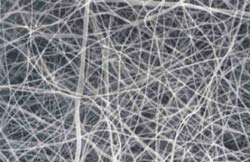New materials developed for vascular graft

A scanning electron micrograph to illustrate the fibrous structure of the tube wall. The fibers are fewer than 500 nanometers in diameter, compared with the average hair shaft, which is 80,000-100,000 nanometers. Photo courtesy of Scott A. Sell/VCU.
In the June issue of the journal Biomedical Materials, researchers reported the design and fabrication of a new material to be used for vascular grafts that in the future could ultimately be implanted in patients undergoing coronary artery graft surgery.
The material is a blend of polydioxanone (PDO), a synthetic biodegradable polymer that has been used in suture materials for years, and elastin fibers, used to enhance elasticity and bioactivity of the graft. Elastin, a natural polymer, is also a major component of the arterial wall and is critical to the graft in providing a base for the cells to recognize and interact with the body. Using a technique known as electrospinning, researchers were able to manipulate the PDO-elastin composite into a conduit, or hose, for use as a small diameter vascular graft.
“We have created a vascular graft with a combination of strength and bioactivity – two things we need to maintain and regenerate the graft. Although the body is the best bioreactor for tissue regeneration or wound healing, we hope this new material will be recognized by the body as an environment conducive for regeneration,” said lead author Gary Bowlin, Ph.D., the Harris professor of biomedical engineering in the VCU School of Engineering.
According to Bowlin, the composition of the material reinforces the graft’s mechanical strength, which is critical in order to hold the blood pressure and forces while the regeneration process is taking place. The PDO-elastin blend undergoes slow degradation and causes few adverse reactions compared with previous materials used for the same purpose, he said. The purpose of the new material would be to help a patient regenerate a new artery. If it works as designed the researchers hope that at six months post-surgery, there would be no more synthetic structure left, he said.
“Regeneration needs to be timed just right, and the cells regrowth needs to be strong enough so that the patient’s own artery can take over for the synthetic material and promote regeneration,” Bowlin said. “Additionally, the synthetic material must degrade, because any foreign material in the body for an extended time is susceptible to inflammatory response or even severe infection such as staphylococcus.”
Bowlin and his colleagues are now evaluating how cells respond and interact with the different structures.
For more than 30 years, surgeons have used Teflon as a conduit or “artery” for such operations. Teflon is inert and once implanted in a patient, remains forever. However, this can lead to complications, especially in small diameter grafts in the arms, lower legs and coronary arteries. In addition, synthetic biodegradable polymers that are currently used may be adversely reactive and cause inflammatory responses, which degrades the materials faster and results in poor wound healing.
This work was supported by a grant from the American Heart Association Mid-Atlantic Affiliate.
Bowlin collaborated with Scott A. Sell, B.S.; Michael J. McClure, B.S.; Catherine P. Barnes, M.S.; and Danielle C. Knapp, M.S., all of the VCU School of Engineering’s Division of Biomedical Engineering; David G. Simpson, Ph.D., VCU Department of Anatomy and Neurobiology; and B. H. Walpoth, M.D., who is affiliated with the University Hospital in Geneva, Switzerland.
Media Contact
More Information:
http://www.vcu.eduAll latest news from the category: Health and Medicine
This subject area encompasses research and studies in the field of human medicine.
Among the wide-ranging list of topics covered here are anesthesiology, anatomy, surgery, human genetics, hygiene and environmental medicine, internal medicine, neurology, pharmacology, physiology, urology and dental medicine.
Newest articles

Superradiant atoms could push the boundaries of how precisely time can be measured
Superradiant atoms can help us measure time more precisely than ever. In a new study, researchers from the University of Copenhagen present a new method for measuring the time interval,…

Ion thermoelectric conversion devices for near room temperature
The electrode sheet of the thermoelectric device consists of ionic hydrogel, which is sandwiched between the electrodes to form, and the Prussian blue on the electrode undergoes a redox reaction…

Zap Energy achieves 37-million-degree temperatures in a compact device
New publication reports record electron temperatures for a small-scale, sheared-flow-stabilized Z-pinch fusion device. In the nine decades since humans first produced fusion reactions, only a few fusion technologies have demonstrated…





















